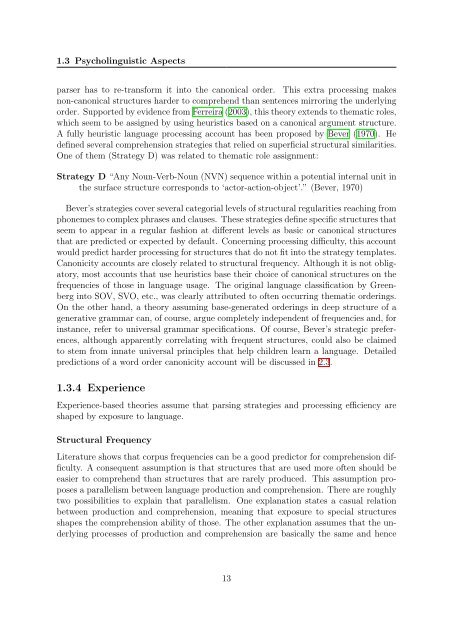Connectionist Modeling of Experience-based Effects in Sentence ...
Connectionist Modeling of Experience-based Effects in Sentence ...
Connectionist Modeling of Experience-based Effects in Sentence ...
You also want an ePaper? Increase the reach of your titles
YUMPU automatically turns print PDFs into web optimized ePapers that Google loves.
1.3 Psychol<strong>in</strong>guistic Aspects<br />
parser has to re-transform it <strong>in</strong>to the canonical order. This extra process<strong>in</strong>g makes<br />
non-canonical structures harder to comprehend than sentences mirror<strong>in</strong>g the underly<strong>in</strong>g<br />
order. Supported by evidence from Ferreira (2003), this theory extends to thematic roles,<br />
which seem to be assigned by us<strong>in</strong>g heuristics <strong>based</strong> on a canonical argument structure.<br />
A fully heuristic language process<strong>in</strong>g account has been proposed by Bever (1970). He<br />
def<strong>in</strong>ed several comprehension strategies that relied on superficial structural similarities.<br />
One <strong>of</strong> them (Strategy D) was related to thematic role assignment:<br />
Strategy D “Any Noun-Verb-Noun (NVN) sequence with<strong>in</strong> a potential <strong>in</strong>ternal unit <strong>in</strong><br />
the surface structure corresponds to ‘actor-action-object’.” (Bever, 1970)<br />
Bever’s strategies cover several categorial levels <strong>of</strong> structural regularities reach<strong>in</strong>g from<br />
phonemes to complex phrases and clauses. These strategies def<strong>in</strong>e specific structures that<br />
seem to appear <strong>in</strong> a regular fashion at different levels as basic or canonical structures<br />
that are predicted or expected by default. Concern<strong>in</strong>g process<strong>in</strong>g difficulty, this account<br />
would predict harder process<strong>in</strong>g for structures that do not fit <strong>in</strong>to the strategy templates.<br />
Canonicity accounts are closely related to structural frequency. Although it is not obligatory,<br />
most accounts that use heuristics base their choice <strong>of</strong> canonical structures on the<br />
frequencies <strong>of</strong> those <strong>in</strong> language usage. The orig<strong>in</strong>al language classification by Greenberg<br />
<strong>in</strong>to SOV, SVO, etc., was clearly attributed to <strong>of</strong>ten occurr<strong>in</strong>g thematic order<strong>in</strong>gs.<br />
On the other hand, a theory assum<strong>in</strong>g base-generated order<strong>in</strong>gs <strong>in</strong> deep structure <strong>of</strong> a<br />
generative grammar can, <strong>of</strong> course, argue completely <strong>in</strong>dependent <strong>of</strong> frequencies and, for<br />
<strong>in</strong>stance, refer to universal grammar specifications. Of course, Bever’s strategic preferences,<br />
although apparently correlat<strong>in</strong>g with frequent structures, could also be claimed<br />
to stem from <strong>in</strong>nate universal pr<strong>in</strong>ciples that help children learn a language. Detailed<br />
predictions <strong>of</strong> a word order canonicity account will be discussed <strong>in</strong> 2.3.<br />
1.3.4 <strong>Experience</strong><br />
<strong>Experience</strong>-<strong>based</strong> theories assume that pars<strong>in</strong>g strategies and process<strong>in</strong>g efficiency are<br />
shaped by exposure to language.<br />
Structural Frequency<br />
Literature shows that corpus frequencies can be a good predictor for comprehension difficulty.<br />
A consequent assumption is that structures that are used more <strong>of</strong>ten should be<br />
easier to comprehend than structures that are rarely produced. This assumption proposes<br />
a parallelism between language production and comprehension. There are roughly<br />
two possibilities to expla<strong>in</strong> that parallelism. One explanation states a casual relation<br />
between production and comprehension, mean<strong>in</strong>g that exposure to special structures<br />
shapes the comprehension ability <strong>of</strong> those. The other explanation assumes that the underly<strong>in</strong>g<br />
processes <strong>of</strong> production and comprehension are basically the same and hence<br />
13
















